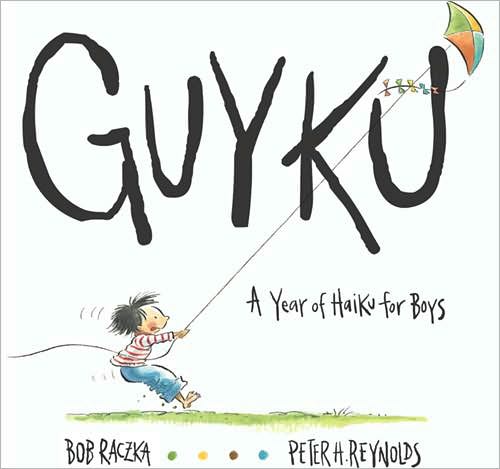
BIBLIOGRAPHY
Raczka, Bob. 2010. GUYKU: A YEAR OF HAIKU FOR BOYS. Ill. by Reynolds, Peter H. New York, NY: Houghton Mifflin Books for Children. ISBN: 978-0-547-24003-9
REVIEW AND CRITICAL ANALYSIS
Author Bob Raczka and illustrator Peter Reynolds have teamed up to create GUYKU: A YEAR OF HAIKU FOR BOYS. This fun book is a great introduction to haiku for kids written from the perspective of a young boy. It was written specifically for boy audience, but even girls would enjoy these playful poems. GUYKU takes the reader through the seasons starting with spring and ending with winter. In each seasonal section Raczka focuses his haiku poems on things that boys would do outdoors during that season. He writes about activities such as kite flying, tree climbing, playing in the leaves, and wishing for a snow day – all of which kids have probably experienced firsthand. Reynolds’ watercolor illustrations complement the poems perfectly. They truly capture the spirit of boys’ outdoor adventures and the simplistic nature of a haiku.
Some of the poems will make readers laugh out loud and
others will trigger a memory of a similar experience. Raczka uses similes, metaphors, and
personification throughout the collection of haiku poems in GUYKU. These literary elements are used to help
convey the fun, lighthearted tone of the poetry while creating a vivid mental image
for the reader.
Skip, skip skip, skip, plunk!
Five ripple rings in a row -
my best throw ever!
This haiku poem, along with the wonderful illustration, portrays the sheer joy that a little boy experiences when he successfully skips a rock on a warm summer day. Raczka masterfully paints pictures with his words throughout this book that will be inviting and fun for young and old readers alike.
Teachers could explain to students the form and characteristics of a haiku after reading GUYKU. They could then take students on a nature walk and have them come up with the topic of their haiku based on what they saw on the walk. This could be in conjunction with a study of the seasons and could be done throughout the year. The poems could be grouped together by season and even by gender and made into class books. The kids would love to read each others haikus.

No comments:
Post a Comment